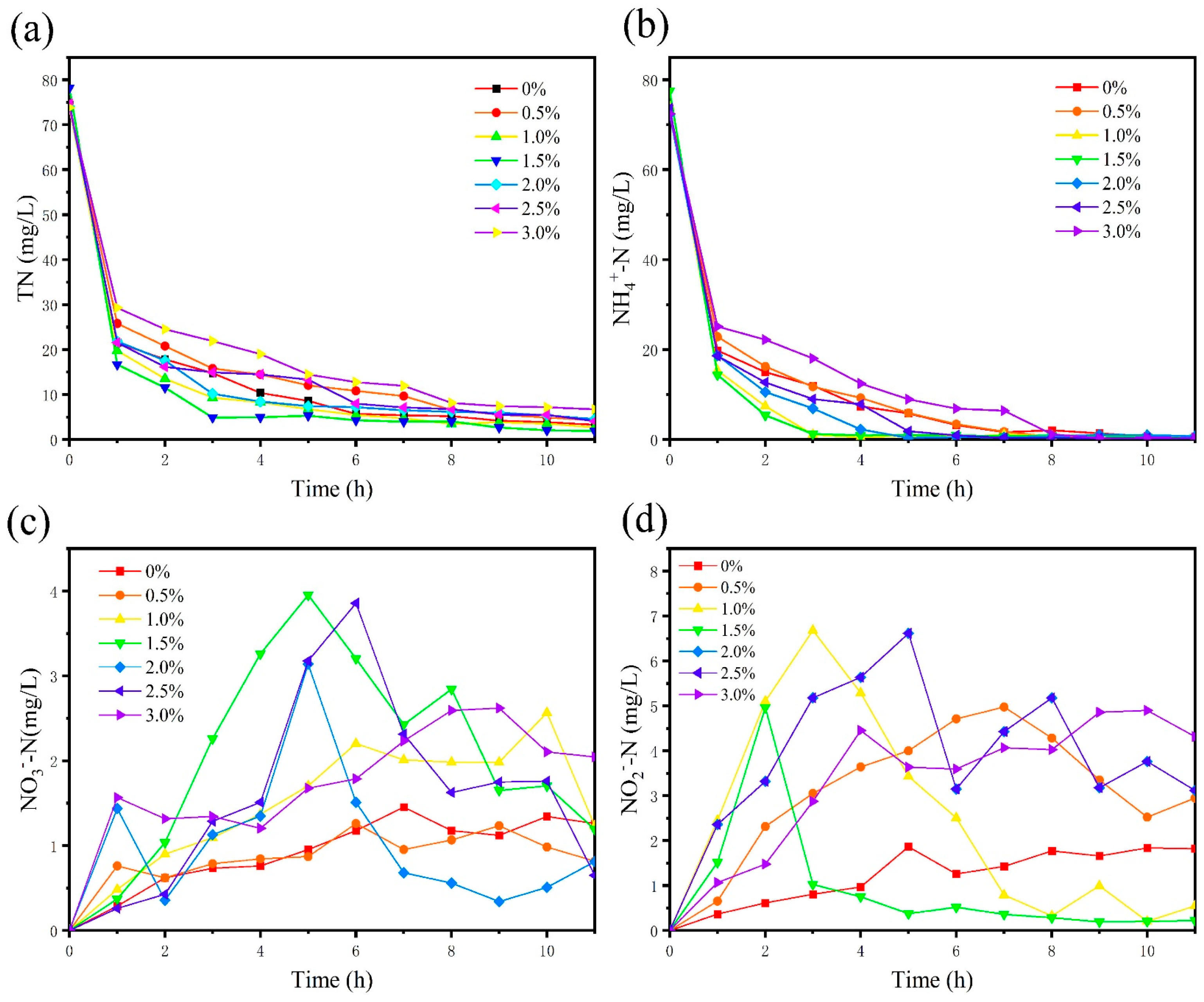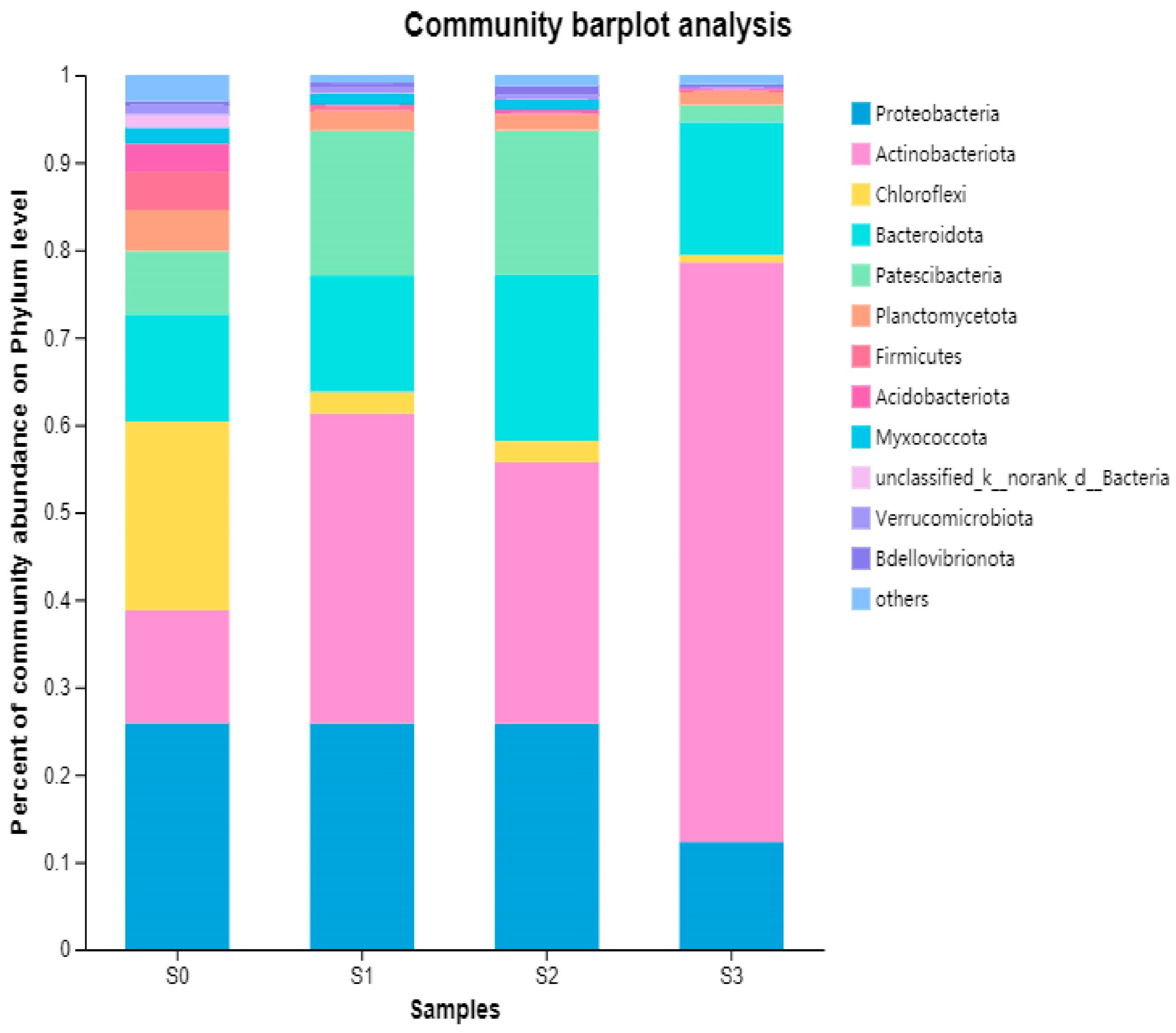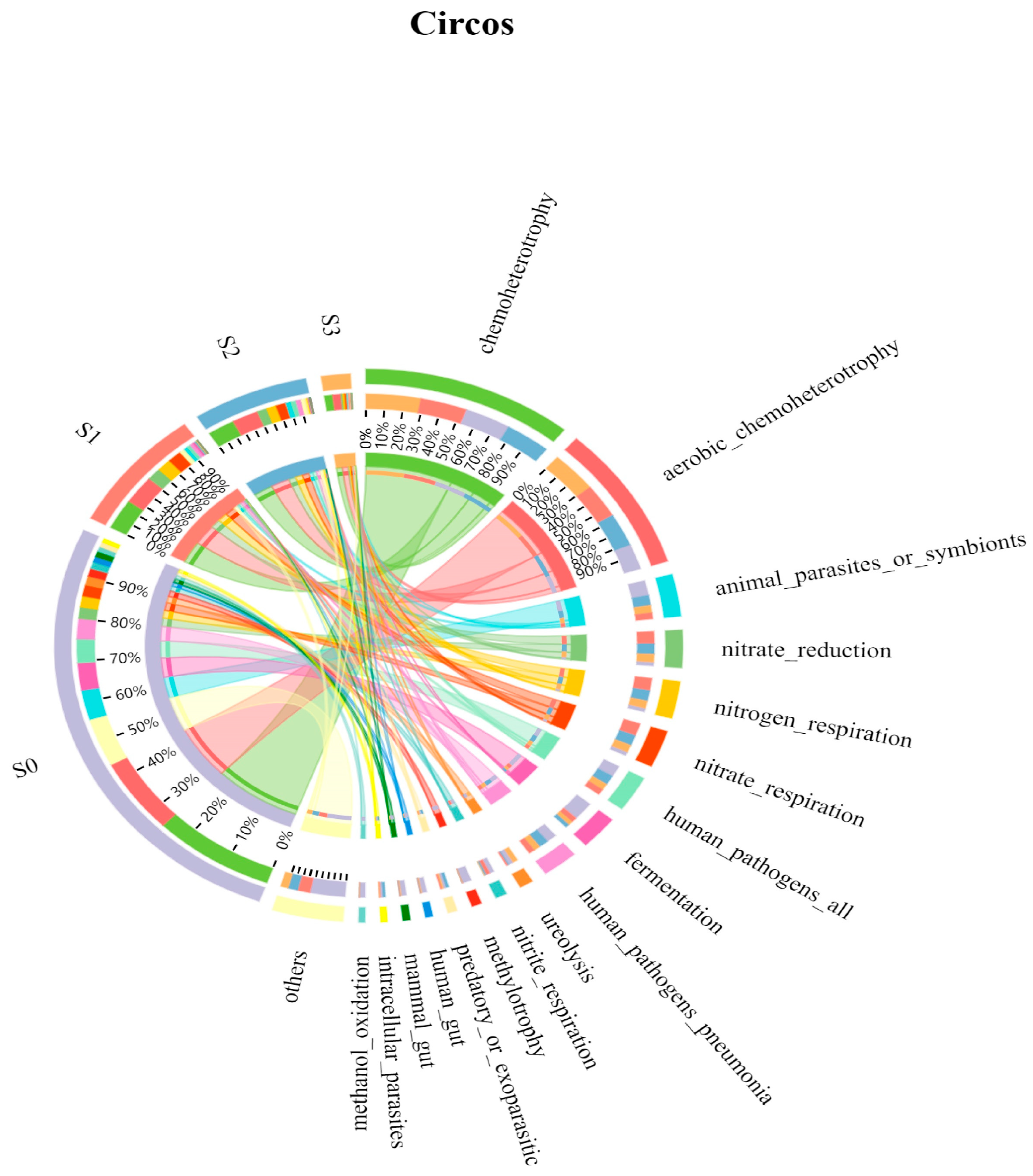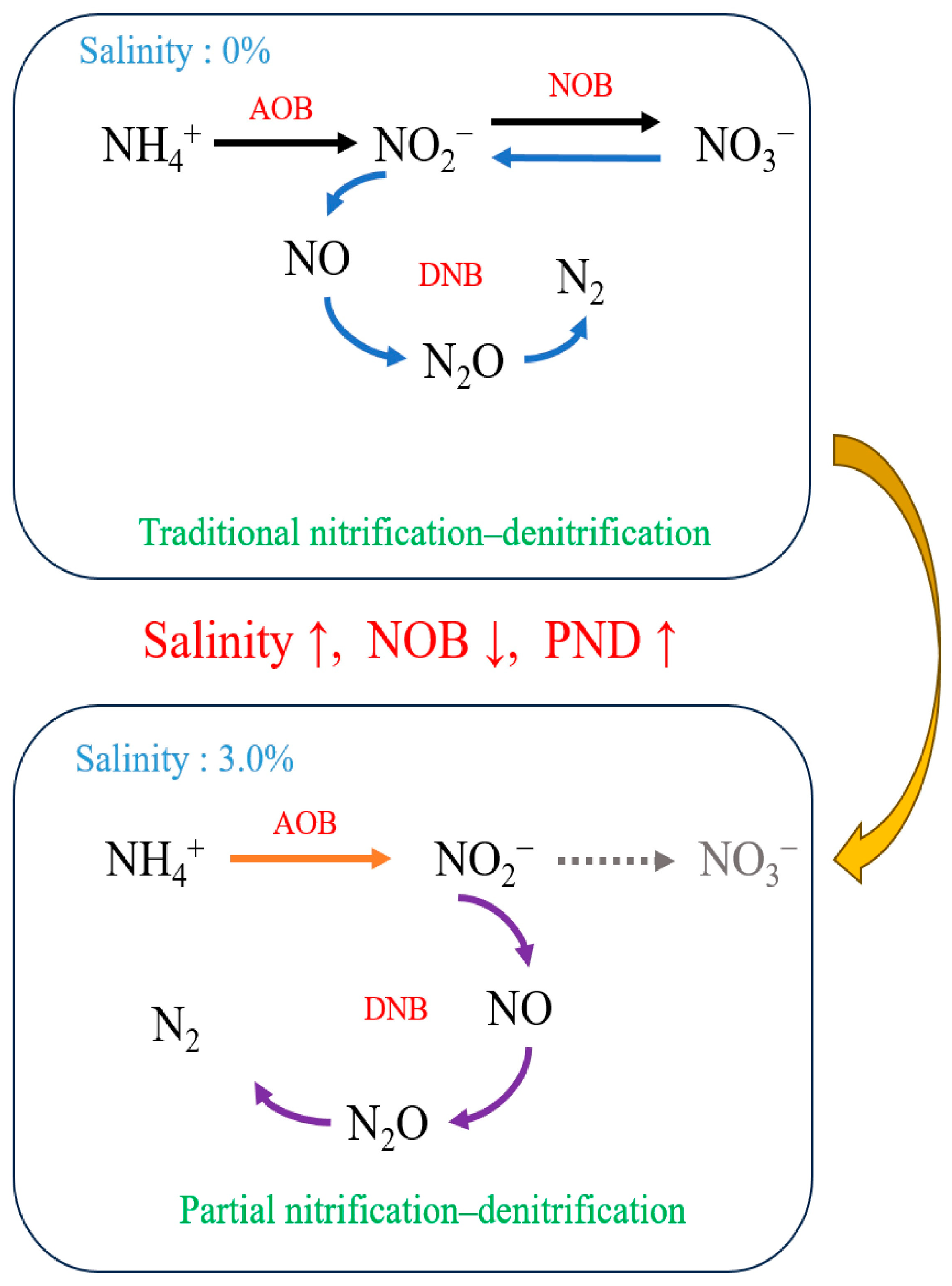Treatment of Pickle Wastewater under Varying Salinity Conditions within the Sequencing Batch Biofilm Reactor System
Abstract
:1. Introduction
2. Materials and Methods
2.1. Experimental Facility
2.2. Inoculated Sludge and Experimental Wastewater
2.3. Experimental Operation Strategy
2.4. Analytical Methods
2.5. Microbial Community Structure Analysis
3. Results and Discussion
3.1. Effect of Salinity Enhancement on System Effluent Quality
3.2. Analysis of the Impact of System Cyclic Denitrification Performance
3.3. Microbial Community Analysis
3.3.1. Microbial Diversity Analysis
3.3.2. Microbial Structure Analysis at Phylum and Genus Level
3.3.3. FAPROTAX Functional Predictive Analysis
3.4. Effects of Salinity on Nitrogen Removal Pathways
4. Conclusions
Supplementary Materials
Author Contributions
Funding
Data Availability Statement
Conflicts of Interest
References
- Liang, Y.; Zhu, H.; Banuelos, G.; Yan, B.; Zhou, Q.; Yu, X.; Cheng, X. Constructed wetlands for saline wastewater treatment: A review. Ecol. Eng. 2017, 98, 275–285. [Google Scholar] [CrossRef]
- He, H.; Chen, Y.; Li, X.; Cheng, Y.; Yang, C.; Zeng, G. Influence of salinity on microorganisms in activated sludge processes: A review. Int. Biodeterior. Biodegrad. 2017, 119, 520–527. [Google Scholar] [CrossRef]
- Liang, Y.; Zhu, H.; Banuelos, G.; Yan, B.; Shutes, B.; Cheng, X.; Chen, X. Removal of nutrients in saline wastewater using constructed wetlands: Plant species, influent loads and salinity levels as influencing factors. Chemosphere 2017, 187, 52–61. [Google Scholar] [CrossRef] [PubMed]
- Mirbolooki, H.; Amirnezhad, R.; Pendashteh, A.R. Treatment of high saline textile wastewater by activated sludge microorganisms. J. Appl. Res. Technol. 2017, 15, 167–172. [Google Scholar] [CrossRef]
- Ahmadi, M.; Jorfi, S.; Kujlu, R.; Ghafari, S.; Soltani, R.D.C.; Haghighifard, N.J. A novel salt-tolerant bacterial consortium for biodegradation of saline and recalcitrant petrochemical wastewater. J. Environ. Manag. 2017, 191, 198–208. [Google Scholar] [CrossRef] [PubMed]
- Saidulu, D.; Gupta, B.; Gupta, A.K.; Ghosal, P.S. A review on occurrences, eco-toxic effects, and remediation of emerging contaminants from wastewater: Special emphasis on biological treatment based hybrid systems. J. Environ. Chem. Eng. 2021, 9, 105282. [Google Scholar] [CrossRef]
- Sierra, J.D.M.; Oosterkamp, M.J.; Wang, W.; Spanjers, H.; van Lier, J.B. Comparative performance of upflow anaerobic sludge blanket reactor and anaerobic membrane bioreactor treating phenolic wastewater: Overcoming high salinity. Chem. Eng. J. 2019, 366, 480–490. [Google Scholar] [CrossRef]
- Chen, D.; Wang, Z.; Zhang, M.; Wang, X.; Lu, S. Effect of increasing salinity and low C/N ratio on the performance and microbial community of a sequencing batch reactor. Environ. Technol. 2021, 42, 1213–1224. [Google Scholar] [CrossRef] [PubMed]
- Khatibi, S.M.H.; Vahed, F.Z.; Sharifi, S.; Ardalan, M.; Shoja, M.M.; Vahed, S.Z. Osmolytes resist against harsh osmolarity: Something old something new. Biochimie 2019, 158, 156–164. [Google Scholar] [CrossRef]
- Zhang, Z.Y.; Zhou, J.T.; Wang, J.; Guo, H.Y.; Tong, J.A. Integration of nitrification and denitrifying dephosphatation in airlift loop sequencing batch biofilm reactor. Process Biochem. 2006, 41, 599–608. [Google Scholar] [CrossRef]
- Chao, C.; Zhao, Y.; Jayant, K.; Ji, M.; Wang, Z.; Li, X. Simultaneous removal of COD, nitrogen and phosphorus and the tridimensional microbial response in a sequencing batch biofilm reactor: With varying C/N/P ratios. Biochem. Eng. J. 2020, 154, 107215. [Google Scholar] [CrossRef]
- Jagaba, A.H.; Kutty, S.R.M.; Noor, A.; Birniwa, A.H.; Affam, A.C.; Lawal, I.M.; Kankia, M.U.; Kilaco, A.U. A systematic literature review of biocarriers: Central elements for biofilm formation, organic and nutrients removal in sequencing batch biofilm reactor. J. Water Process Eng. 2021, 42, 102178. [Google Scholar] [CrossRef]
- Wang, J.; Zhou, J.; Wang, Y.; Wen, Y.; He, L.; He, Q. Efficient nitrogen removal in a modified sequencing batch biofilm reactor treating hypersaline mustard tuber wastewater: The potential multiple pathways and key microorganisms. Water Res. 2020, 177, 115734. [Google Scholar] [CrossRef] [PubMed]
- Fu, B.; Liao, X.; Ding, L.; Ren, H. Characterization of microbial community in an aerobic moving bed biofilm reactor applied for simultaneous nitrification and denitrification. World J. Microbiol. Biotechnol. 2010, 26, 1981–1990. [Google Scholar] [CrossRef]
- Chen, W.; Dai, X.; Cao, D.; Wang, S.; Hu, X.; Liu, W.; Yang, D. Performance and microbial ecology of a nitritation sequencing batch reactor treating high-strength ammonia wastewater. Sci. Rep. 2016, 6, 35693. [Google Scholar] [CrossRef] [PubMed]
- Wang, J.; Li, L.; Liu, Y.; Li, W. A review of partial nitrification in biological nitrogen removal processes: From development to application. Biodegradation 2021, 32, 229–249. [Google Scholar] [CrossRef] [PubMed]
- HJ 828-2017; Water Quality-Determination of the Chemical Oxygen Demand-Dichromatemethod. 2017. Available online: https://www.chinesestandard.net/PDF.aspx/HJ828-2017 (accessed on 24 April 2024).
- HJ 636-2012; Water Quality-Determination of Total Nitrogen-Alkaline Potassium Persulfate Digestion UV Spectrophotometric Method. Available online: https://www.chinesestandard.net/PDF.aspx/HJ636-2012 (accessed on 24 April 2024).
- HJ 535-2009; Water Quality―Determination of Ammonia Nitrogen―Nessler’s Reagent Spectrophotometry. 2009. Available online: https://www.chinesestandard.net/PDF.aspx/HJ535-2009 (accessed on 24 April 2024).
- GB 7480-87; Water Quality-Determination of Nitrate-Spectrophotometric Method with Phenol Disulfonic Acid, China. 1987. Available online: https://english.mee.gov.cn/Resources/standards/water_environment/method_standard2/200807/t20080710_125451.shtml (accessed on 24 April 2024).
- GB 7493-87; Water Quality-Determination of Nitrogen (Nitrite)-Spectrophotometric Method. 1987. Available online: https://english.mee.gov.cn/Resources/standards/water_environment/method_standard2/200807/t20080710_125478.shtml (accessed on 24 April 2024).
- Zhang, X.; Medrano, R.F.; Wang, M.; Beauchemin, K.A.; Ma, Z.; Wang, R.; Wen, J.; Bernard, L.A.; Tan, Z. Effects of urea plus nitrate pretreated rice straw and corn oil supplementation on fiber digestibility, nitrogen balance, rumen fermentation, microbiota and methane emissions in goats. J. Anim. Sci. Biotechnol. 2019, 10, 6. [Google Scholar] [CrossRef] [PubMed]
- Huang, Z.; Wang, Y.; Jiang, L.; Xu, B.; Wang, Y.; Zhao, H.; Zhou, W. Mechanism and performance of a self-flocculating marine bacterium in saline wastewater treatment. Chem. Eng. J. 2018, 334, 732–740. [Google Scholar] [CrossRef]
- Sierra, J.D.M.; Oosterkamp, M.J.; Wang, W.; Spanjers, H.; van Lier, J.B. Impact of long-term salinity exposure in anaerobic membrane bioreactors treating phenolic wastewater: Performance robustness and endured microbial community. Water Res. 2018, 141, 172–184. [Google Scholar] [CrossRef]
- Luo, W.; Phan, H.V.; Hai, F.I.; Price, W.E.; Guo, W.; Ngo, H.H.; Yamamoto, K.; Nghiem, L.D. Effects of salinity build-up on the performance and bacterial community structure of a membrane bioreactor. Bioresour. Technol. 2016, 200, 305–310. [Google Scholar] [CrossRef]
- Chen, H.; Wang, Y.; Chen, Z.; Wu, Z.; Chu, X.; Qing, S.; Xu, L.; Yang, K.; Meng, Q.; Cheng, H.; et al. Effects of salinity on anoxic-oxic system performance, microbial community dynamics and co-occurrence network during treating wastewater. Chem. Eng. J. 2023, 461, 141969. [Google Scholar] [CrossRef]
- Chen, J.; Han, Y.; Wang, Y.; Gong, B.; Zhou, J.; Qing, X. Start-up and microbial communities of a simultaneous nitrogen removal system for high salinity and high nitrogen organic wastewater via heterotrophic nitrification. Bioresour. Technol. 2016, 216, 196–202. [Google Scholar] [CrossRef] [PubMed]
- Choi, H.-J.; Lee, S.-M.; Choi, C.-H.; Kwon, M.-C.; Lee, H.-Y. Influence of the wastewater composition on denitrification and biological p-removal in the S-DN-P-process (b) Effect of acetate. J. Hazard. Mater. 2008, 158, 151–156. [Google Scholar] [CrossRef] [PubMed]
- Lu, J.; Yan, X.; Ma, Y.-f.; Tian, C.-x.; Ding, J.-c. Impact of salinity on treatment of saline wastewater by sequencing batch biofilm reactor process. J. Cent. S. Univ. 2014, 21, 1989–1994. [Google Scholar] [CrossRef]
- Guo, J.; Peng, Y.; Huang, H.; Wang, S.; Ge, S.; Zhang, J.; Wang, Z. Short- and long-term effects of temperature on partial nitrification in a sequencing batch reactor treating domestic wastewater. J. Hazard. Mater. 2010, 179, 471–479. [Google Scholar] [CrossRef] [PubMed]
- She, Z.; Zhao, L.; Zhang, X.; Jin, C.; Guo, L.; Yang, S.; Zhao, Y.; Gao, M. Partial nitrification and denitrification in a sequencing batch reactor treating high-salinity wastewater. Chem. Eng. J. 2016, 288, 207–215. [Google Scholar] [CrossRef]
- Aslan, S.; Simsek, E. Influence of salinity on partial nitrification in a submerged biofilter. Bioresour. Technol. 2012, 118, 24–29. [Google Scholar] [CrossRef] [PubMed]
- Zhang, L.; Gao, G.; Tang, X.; Shao, K.; Bayartu, S.; Dai, J. Bacterial community changes along a salinity gradient in a Chinese wetland. Can. J. Microbiol. 2013, 59, 611–619. [Google Scholar] [CrossRef]
- Chu, G.; Yu, D.; Wang, X.; Wang, Q.; He, T.; Zhao, J. Comparison of nitrite accumulation performance and microbial community structure in endogenous partial denitrification process with acetate and glucose served as carbon source. Bioresour. Technol. 2021, 320, 124405. [Google Scholar] [CrossRef]
- Zhang, M.; Gao, J.; Fan, Y.; Liu, Q.; Zhu, C.; Ge, L.; He, C.; Wu, J. Comparisons of nitrite accumulation, microbial behavior and nitrification kinetic in continuous stirred tank (ST) and plug flow (PF) moving bed biofilm reactors. Chemosphere 2021, 278, 130410. [Google Scholar] [CrossRef]
- Shukla, R.; Ahammad, S.Z. Performance evaluation and microbial community structure of a modified trickling filter and conventional activated sludge process in treating urban sewage. Sci. Total Environ. 2022, 853, 158331. [Google Scholar] [CrossRef] [PubMed]
- Fang, H.; Cai, L.; Yu, Y.; Zhang, T. Metagenomic analysis reveals the prevalence of biodegradation genes for organic pollutants in activated sludge. Bioresour. Technol. 2013, 129, 209–218. [Google Scholar] [CrossRef] [PubMed]
- Tang, B.; Chen, Q.; Bin, L.; Huang, S.; Zhang, W.; Fu, F.; Li, P. Insight into the microbial community and its succession of a coupling anaerobic-aerobic biofilm on semi-suspended bio-carriers. Bioresour. Technol. 2018, 247, 591–598. [Google Scholar] [CrossRef] [PubMed]
- Li, L.; Dong, Y.; Qian, G.; Hu, X.; Ye, L. Performance and microbial community analysis of bio-electrocoagulation on simultaneous nitrification and denitrification in submerged membrane bioreactor at limited dissolved oxygen. Bioresour. Technol. 2018, 258, 168–176. [Google Scholar] [CrossRef] [PubMed]
- He, Q.; Song, Q.; Zhang, S.; Zhang, W.; Wang, H. Simultaneous nitrification, denitrification and phosphorus removal in an aerobic granular sequencing batch reactor with mixed carbon sources: Reactor performance, extracellular polymeric substances and microbial successions. Chem. Eng. J. 2018, 331, 841–849. [Google Scholar] [CrossRef]
- Fujii, N.; Kuroda, K.; Narihiro, T.; Aoi, Y.; Ozaki, N.; Ohashi, A.; Kindaichi, T. Metabolic Potential of the Superphylum Patescibacteria Reconstructed from Activated Sludge Samples from a Municipal Wastewater Treatment Plant. Microbes Environ. 2022, 37, ME22012. [Google Scholar] [CrossRef] [PubMed]
- Liu, W.T.; Hanada, S.; Marsh, T.L.; Kamagata, Y.; Nakamura, K. Kineosphaera limosa gen. nov., sp nov., a novel Gram-positive polyhydroxyalkanoate-accumulating coccus isolated from activat sludge. Int. J. Syst. Evol. Microbiol. 2002, 52, 1845–1849. [Google Scholar] [CrossRef] [PubMed]
- Zhao, Y.; Park, H.-D.; Park, J.-H.; Zhang, F.; Chen, C.; Li, X.; Zhao, D.; Zhao, F. Effect of different salinity adaptation on the performance and microbial community in a sequencing batch reactor. Bioresour. Technol. 2016, 216, 808–816. [Google Scholar] [CrossRef] [PubMed]
- Zhang, L.; Hao, S.; Wang, Y.; Lan, S.; Dou, Q.; Peng, Y. Rapid start-up strategy of partial denitrification and microbially driven mechanism of nitrite accumulation mediated by dissolved organic matter. Bioresour. Technol. 2021, 340, 125663. [Google Scholar] [CrossRef]
- Liu, Y.; Lai, Q.; Wang, W.; Shao, Z. Defluviimonas nitratireducens sp nov., isolated from surface seawater. Int. J. Syst. Evol. Microbiol. 2017, 67, 2752–2757. [Google Scholar] [CrossRef]
- Ye, L.; Shao, M.-F.; Zhang, T.; Tong, A.H.Y.; Lok, S. Analysis of the bacterial community in a laboratory-scale nitrification reactor and a wastewater treatment plant by 454-pyrosequencing. Water Res. 2011, 45, 4390–4398. [Google Scholar] [CrossRef] [PubMed]
- Gao, X.-Y.; Xu, Y.; Liu, Y.; Liu, Y.; Liu, Z.-P. Bacterial diversity, community structure and function associated with biofilm development in a biological aerated filter in a recirculating marine aquaculture system. Mar. Biodivers. 2012, 42, 1–11. [Google Scholar] [CrossRef]
- Guo, Y.; Zhou, X.; Li, Y.; Li, K.; Wang, C.; Liu, J.; Yan, D.; Liu, Y.; Yang, D.; Xing, J. Heterotrophic nitrification and aerobic denitrification by a novel Halomonas campisalis. Biotechnol. Lett. 2013, 35, 2045–2049. [Google Scholar] [CrossRef]
- Louca, S.; Parfrey, L.W.; Doebeli, M. Decoupling function and taxonomy in the global ocean microbiome. Science 2016, 353, 1272–1277. [Google Scholar] [CrossRef] [PubMed]
- Xu, Z.; Ma, Y.; Zhang, L.; Han, Y.; Yuan, J.; Li, G.; Luo, W. Relating bacterial dynamics and functions to gaseous emissions during composting of kitchen and garden wastes. Sci. Total Environ. 2021, 767, 144210. [Google Scholar] [CrossRef] [PubMed]
- Zhang, M.; Wang, Z.-J.; Huang, J.-C.; Sun, S.; Cui, X.; Zhou, W.; He, S. Salinity-driven nitrogen removal and its quantitative molecular mechanisms in artificial tidal wetlands. Water Res. 2021, 202, 117446. [Google Scholar] [CrossRef]
- Chyan, J.M.; Huang, S.C.; Lin, C.J. Impacts of salinity on degradation of pollutions in hybrid constructed wetlands. Int. Biodeterior. Biodegrad. 2017, 124, 176–187. [Google Scholar] [CrossRef]







| Sample | Sobs | Sequences | Shannon | Simpson | ACE | Chao | Coverage |
|---|---|---|---|---|---|---|---|
| S0 | 3446 | 327,372 | 6.238043 | 0.005425 | 3489.067393 | 3460.145492 | 0.99964 |
| S1 | 985 | 74,459 | 3.87143 | 0.062969 | 1328.840345 | 1325.620438 | 0.99589 |
| S2 | 779 | 77,792 | 3.840726 | 0.063959 | 1005.733817 | 1027.65625 | 0.997185 |
| S3 | 288 | 30,825 | 2.098761 | 0.396125 | 395.226902 | 383.357143 | 0.99708 |
| Name | S0 (%) | S1 (%) | S2 (%) | S3 (%) |
|---|---|---|---|---|
| Nitrosomonas | 0.19 | 0.05 | 0.06 | 0.02 |
| Nitrospira | 0.44 | 0.01 | 0.01 | 0.00 |
| Defluviimonas | 0.25 | 7.32 | 9.20 | 3.97 |
| Thauera | 0.56 | 0.95 | 0.36 | 0.01 |
| Zoogloea | 0.46 | 0.00 | 0.00 | 0.00 |
| Denitromonas | 0.02 | 1.45 | 2.25 | 1.17 |
| Saccharimonadales | 4.87 | 8.77 | 7.76 | 1.84 |
| Flavobacterium | 0.70 | 4.70 | 2.14 | 0.02 |
| Terrimonas | 0.99 | 0.20 | 0.05 | 0.00 |
| Ferruginibacter | 0.54 | 0.00 | 0.00 | 0.00 |
| Dokdonella | 1.49 | 0.06 | 0.07 | 0.02 |
| Pseudomonas | 0.02 | 0.01 | 0.01 | 0.00 |
| Marinicella | 0.00 | 0.00 | 0.00 | 0.41 |
| Halomonas | 0.02 | 0.01 | 0.03 | 0.19 |
| Phaeodactylibacter | 0.13 | 0.14 | 0.03 | 0.00 |
| Defluviicoccus | 0.18 | 4.44 | 1.11 | 0.05 |
| Sample | Functional Groups | Relative Abundance (%) |
|---|---|---|
| S0 | Chemoheterotrophy | 25.88 |
| Aerobic chemoheterotrophy | 18.11 | |
| Animal parasites or symbionts | 7.17 | |
| Fermentation | 6.59 | |
| Human pathogens | 5.77 | |
| S1 | Chemoheterotrophy | 26.41 |
| Aerobic chemoheterotrophy | 24.65 | |
| Nitrate reduction | 10.79 | |
| Nitrogen respiration | 10.78 | |
| Nitrate respiration | 10.78 | |
| S2 | Chemoheterotrophy | 25.27 |
| Aerobic chemoheterotrophy | 24.25 | |
| Nitrate reduction | 9.15 | |
| Nitrogen respiration | 9.13 | |
| Nitrate respiration | 9.12 | |
| S3 | Chemoheterotrophy | 30.94 |
| Aerobic chemoheterotrophy | 29.90 | |
| Nitrate reduction | 7.29 | |
| Nitrogen respiration | 6.76 | |
| Nitrate respiration | 3.62 |
Disclaimer/Publisher’s Note: The statements, opinions and data contained in all publications are solely those of the individual author(s) and contributor(s) and not of MDPI and/or the editor(s). MDPI and/or the editor(s) disclaim responsibility for any injury to people or property resulting from any ideas, methods, instructions or products referred to in the content. |
© 2024 by the authors. Licensee MDPI, Basel, Switzerland. This article is an open access article distributed under the terms and conditions of the Creative Commons Attribution (CC BY) license (https://creativecommons.org/licenses/by/4.0/).
Share and Cite
Shen, N.; Guo, H.; Yao, T.; Xu, L.; Gao, Y.; Yang, P. Treatment of Pickle Wastewater under Varying Salinity Conditions within the Sequencing Batch Biofilm Reactor System. Water 2024, 16, 1312. https://doi.org/10.3390/w16091312
Shen N, Guo H, Yao T, Xu L, Gao Y, Yang P. Treatment of Pickle Wastewater under Varying Salinity Conditions within the Sequencing Batch Biofilm Reactor System. Water. 2024; 16(9):1312. https://doi.org/10.3390/w16091312
Chicago/Turabian StyleShen, Nuonan, Hongyun Guo, Tingting Yao, Li Xu, Youxian Gao, and Ping Yang. 2024. "Treatment of Pickle Wastewater under Varying Salinity Conditions within the Sequencing Batch Biofilm Reactor System" Water 16, no. 9: 1312. https://doi.org/10.3390/w16091312




